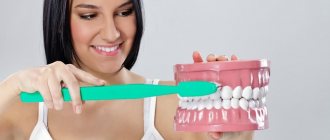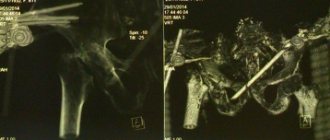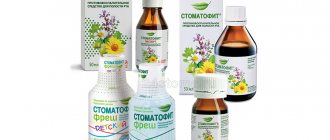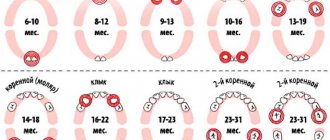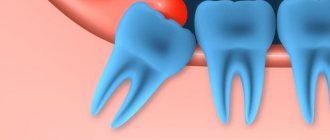Young children are susceptible to many diseases and ailments, which are sometimes difficult to understand even for the most experienced pediatrician. Unlike an adult, a baby cannot explain what exactly is bothering him or which area of the body needs attention, so young parents often confuse one problem of his well-being with another.
For example, there are regularly cases when a baby is brought in for examination complaining of a cold, when in fact he was worried about the eruption of baby teeth. But how to distinguish one from the other?
Etiology of teething
In some cases, the process of teething in children is asymptomatic, but sometimes the baby experiences discomfort and even unpleasant sensations due to pain when teeth move out of the gums. Teething is sometimes accompanied by a number of other symptoms, which may not necessarily appear all together, but their combination indicates quite clearly the cause of the problem:
- swelling and redness of the gums;
- disrupted eating and sleeping patterns;
- sudden changes in mood;
- a pronounced desire to put foreign objects into the mouth;
- slight redness of the ears and cheeks;
- excessive salivation, sometimes leading to coughing;
- occasionally small hematomas on the gums;
- slightly elevated temperature.
Teething often brings serious discomfort to the baby.
Individually, each of these signs may not indicate teething, so if a child has any of the described symptoms, it is necessary to conduct a diagnosis in order to detect others. The primary one is an increase in temperature, which is why it is sometimes difficult to distinguish an erupting thrush from a cold. This also includes spoiled appetite and sleep.
You may also be interested in
CHILDHOOD
Finger wipes from 0 to 3 years ASEPTA BABY
For gentle oral hygiene of babies and massage of gums during the eruption of the first teeth
More about the product
CHILDHOOD
Children's gel toothpaste from 0 to 3 years ASEPTA BABY
Designed for gentle care of baby's gums and baby teeth
More about the product
Don't rush with complementary foods
As you know, a child’s first molars begin to appear at the age of 6 months. This period in life is also associated with a change in eating habits. It is important that during this period complementary foods are not introduced abruptly or in large quantities - this is a stressful situation for the child, which will provoke a decrease in immunity.
In addition, at the same time, a change in “antibodies” occurs in the baby’s body. While in the womb and in the first months of life, the child’s immune system “works” with the help of antibodies from the mother’s body. And it is at six months that “maternal” antibodies begin to be replaced by “own-produced” antibodies, and the fragile immune system may not cope on its own.
If your baby's teething process is painful, delay introducing solid foods. Remember that breast milk meets 90% of a baby's needs up to the age of 1 year.
Monitor air humidity and take walks
If several teeth are cut at the same time or one by one, then a runny nose can last for a week. At the same time, if the color of the discharge does not acquire a pathological shade characteristic of infectious diseases, there is no need to be overly nervous about this. If there is no fever and the child is alert, he can be bathed.
If you have a runny nose due to the first teeth, fresh air and maintaining normal humidity in the room help. Frequent airing and walks in nature will help ease this period for the baby.
Use medications only when absolutely necessary
In such situations, taking strong medications should be avoided. Including those that affect vascular tone. The small body quickly gets used to them and in the future will not be able to cope with breathing without the constant use of medications. In critical cases, the use of vasoconstrictor drugs is allowed for 6 days, no more. In addition, they must be with a strictly “children’s” dosage of the active substance and used in the dosage prescribed by the doctor.
To relieve general pain syndromes, children are recommended to be given anti-inflammatory and antipyretic drugs. They will help get rid of unpleasant sensations, but, alas, will not affect the abundance of phlegm.
Cleaning baby's nose
You can remove mucus yourself, using baby syringes or nasal aspirators, which are produced, for example, in the shape of funny animals and will not scare the baby; on the contrary, they will make the procedure of cleaning the nose fun.
In addition, syringes and nasal aspirators have different operating principles. If, with the help of the first, a certain solution is poured into the spout, and then it is removed from the nasal sinus, then nasal aspirators gently suck out excess mucus without causing the child any unpleasant sensations. They are mechanical and electronic.
In addition, to clean the sinuses, you can use thick cotton or gauze swabs or special wet baby wipes rolled into thick soft tubes.
You need to get rid of snot several times a day, in a way convenient for you.
However, experts do not recommend using sprays to clean the nose, since in children they can cause spasms of the vocal cords or simply scare the child.
At the same time, while getting rid of mucus from one nasal sinus, the second one must be carefully closed. It is better to clean the nose periodically so that the snot does not irritate the throat or get into the bronchi, maxillary sinuses or ears.
The cleansing process may not always be pleasant. Delicate mucous membranes will react sharply to it - with coughing reactions or even nausea. But after 3-4 procedures, if there were any negative reactions, they will disappear.
Basic rules for dealing with a runny nose during teething in a baby
The process of the appearance of new incisors and molars is not always accompanied by a runny nose. For many parents, this process can go unnoticed. Experts have come up with several “general” rules, the observance of which is useful for the child as a whole, but during such a runny nose it will make life much easier for both the baby and adults:
- Walks in the open air. The more time a child spends outside, in comfortable conditions, the easier it will be for him to breathe. Even in the cleanest house there is dust and similar irritants that aggravate a child's runny nose.
- The air temperature in the house should not be lower than +17 or higher than +22.
- The air humidity in the children's room should not be lower than 55% or higher than 75%.
- Gently remove mucus from the baby's nose. Make sure that the mucous surfaces are not overdried.
- Monitor the type of discharge. If they are opaque and thick, this is a reason to worry.
- Give the child a lot to drink to compensate for the loss of moisture (excessive tears, snot, salivation reduces the level of water in the body, and this can lead to drying out of the mucous membranes, an increase in temperature and the onset of inflammatory processes).
- Keep calm. If a runny nose is not a symptom of a disease, then it will go away on its own. You need to come to terms with it and only make this period as easy as possible for the baby.
Prevention of runny nose and cough during teething in a child
There are no specific measures to prevent these unpleasant symptoms. However, following general hygiene and feeding recommendations will help keep your baby's body healthy and able to resist infection.
Recommended:
- Exclusive breastfeeding up to 6 months.
- If the child is bottle-fed, it is also not recommended to introduce complementary foods before six months.
- Gradual introduction of complementary foods focusing on the baby's nutritional interest.
- Maintaining the child’s personal hygiene, including oral hygiene. Asepta Baby finger wipes are great for this, helping to remove food debris and plaque from the baby’s gums and teeth.
- Correct daily routine, walks in the fresh air, cleanliness of the room and maintaining an optimal microclimate.
These rules will help support the child’s immunity, so that he can better cope with difficult trials for him, such as teething.
We hope your baby's teething process is painless and you get a good night's sleep. And if unpleasant sensations still bother your baby, ASEPTA BABY finger wipes for 0 to 3 years will help provide a gentle massage and relieve gum pain. Impregnation with plant extracts prevents inflammation and allows you to maintain the acid-base balance of the oral cavity.
Etiology of the common cold
From a medical point of view, a cold should be called directly only the cooling of the body, which led to one of the probable diseases, but in colloquial speech a number of diseases are called a cold. And although they all have a different nature of occurrence, based on such a provocative factor as hypothermia, they are usually combined into a common group:
- rhinitis;
- ARVI;
- pharyngitis (nasopharyngitis);
- laryngitis.
All these diseases have a different clinical picture with some common symptoms, and although in some ways they may resemble the symptoms of a malaise in which the baby is teething, there should be no problems with how to distinguish one from the other.
I had contact with a person who was sick. Will I inevitably get sick too?
The risk of contracting COVID-19 in close contact is really high. The new coronavirus is more contagious than the influenza virus (i.e., the ability to be transmitted to others). You will be much more likely to get sick during the first 14 days. Since transmission of coronavirus infection is possible several days before the onset of symptoms, during these days, when communicating with relatives (especially the elderly), be sure to use a mask. Remember that if you have been in contact with infected people, you can, in turn, pose a danger to others.
